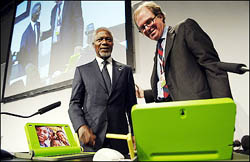 “Demo or die.” That was the creed of the MIT Media Lab in the glory days — days of ferment that produced important, foundational work in interactive media. Well, yesterday at the World Summit on the Information Society in Tunisia, where Nicholas Negroponte and Kofi Annan were unveiling the prototype of the 100 dollar laptop, the demo died. Or rather, the demo just didn’t happen.
“Demo or die.” That was the creed of the MIT Media Lab in the glory days — days of ferment that produced important, foundational work in interactive media. Well, yesterday at the World Summit on the Information Society in Tunisia, where Nicholas Negroponte and Kofi Annan were unveiling the prototype of the 100 dollar laptop, the demo died. Or rather, the demo just didn’t happen.
As it turns out, Negroponte wasn’t able to get past the screen lock on the slick lime-green device, so the mob of assembled journalists and technofiles had to accept the 100 dollar gospel on faith, making do with touching anecdotes about destitute families huddled in wonder around their child’s new laptop, the brightest source of light in their tiny hovel. All told, an inauspicious beginning for the One Laptop Per Child intitiative, which aims to put millions of cheap, robust, free-software-chugging computers into the hands of the world’s poorest children.
Sorry to be so snide, but we were watching the live webcast from Tunis yesterday… it’s hard not to laugh at the leaders of the free world bumbling over this day-glo gadget, this glorified Trapper Keeper cum jack-in-the-box (Annan ended up breaking the hand crank), with barely a word devoted to what educational content will actually go inside, or to how teachers plan to construct lessons around these new toys. In the end, it’s going to come down to them. Good teachers, who know computers, may be able to put the laptops to good use. But somehow I’m getting visions of stacks of unused or busted laptops, cast aside like so many neon bricks.
A sunnier future for the 100 dollar laptop? A commercial company obtains the rights and starts selling them in the West for $250 a pop. They’re a huge hit. Everyone just has to have one to satisfy their poor inner child.
if:book
A Project of the Institute for the Future of the Book

Like you I am apprehensive about this. If done wrong it might actually turn a generation of kids in developing countries against computers.
P.S. I might add a niggle to the ones you’ve had already – the demo machines in the picture seem to have colour screens while the first generation units (according to the FAQ) will be black and white.
And the question again comes down to teaching. I have been to a daycare in Bridgeport where I’ve spent much time pulling crayons out of computers available to all from age 2 on up (Although I must admit I was thrilled by the flat yellow plastic daisy I found in the CD tray as evidence of a thinking mind). The computers and software programs must be carefully selected BUT there must be teachers who are willing to take the extra measures of showing and explaining the medium. For me, I felt the first thing to teach was to respect the school’s property and how to properly use a computer.
>> the demo machines in the picture seem to have colour screens while the first generation units (according to the FAQ) will be black and white.
The displays will be both. The HW designers came up with a new design to support low res color and high res b&w. They achieve this by using colored back-lighting (then 3 display dots = 1 color pixel). In b&w mode each dot = 1 pixel, giving you the higher res.